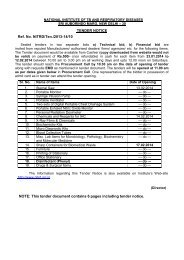October - LRS Institute of Tuberculosis & Respiratory Diseases
October - LRS Institute of Tuberculosis & Respiratory Diseases
October - LRS Institute of Tuberculosis & Respiratory Diseases
Create successful ePaper yourself
Turn your PDF publications into a flip-book with our unique Google optimized e-Paper software.
TUBERCULOSIS OF SPINE 215<br />
whether by natural process alone or buttressed<br />
by operative fusion. This is the established and<br />
most excellent rule to be disobeyed rarely and<br />
then only for sound reasons”. He also states<br />
“A ‘fusion’ that will not fuse is a long miserable<br />
and most disheartening business”.<br />
The method was described by Hibbs at the<br />
turn <strong>of</strong> the century. In 1930’s a lively controversy<br />
arose about the timing <strong>of</strong> the operation,<br />
whether it should be done during the activity<br />
<strong>of</strong> the disease or after it had healed. Thanks to<br />
the advent <strong>of</strong> chemotherapeutics in forties, the<br />
controversy had a natural death. Now-a-days,<br />
there is no need for posterior spinal fusion even<br />
though some die-hards still swear by it.<br />
Era <strong>of</strong> Chemotherapy<br />
With the isolation <strong>of</strong> streptomycin from<br />
Streptomyces griseaus (Schatz et al, 1964;<br />
Schatz and Waksman 1944) a new era has<br />
started in the treatment <strong>of</strong> tuberculosis. Several<br />
chemotheraputic agents specific against Mycobacterium<br />
tuberculosis have since been developed<br />
in quick succession.<br />
With the arrival <strong>of</strong> chemotherapy, the<br />
natural history <strong>of</strong> tuberculosis has changed.<br />
For the first time, specific drugs became available<br />
against tubercle bacillus. The merits <strong>of</strong><br />
chemotherapy are that the patients no longer<br />
die but are cured, the period <strong>of</strong> infectivity is<br />
considerably reduced, relapses are avoided and<br />
the chronicity disappears. The patients with<br />
drug-sensitive bacilli on right drugs, taken<br />
regularly, have excellent chances <strong>of</strong> cure in<br />
twelve months.<br />
As with other organisms, the development <strong>of</strong><br />
resistance to drugs is not uncommon with<br />
tubercle bacillus. Hence a combination <strong>of</strong><br />
drugs is more effective than a single drug.<br />
Streptomycin Sulphate<br />
Streptomycin was isolated from Streptomyces<br />
griseaus (Schatz et al, 1944). It is an<br />
aminoglycoside and tribasic substance. It is<br />
bactericidal in action. Among its toxic effects<br />
ototoxicity involving auditory and/or vestibular<br />
pathways <strong>of</strong> eight nerve may occur. However,<br />
in the author’s experience, the incidence <strong>of</strong><br />
ototoxicity among the South Indian patients<br />
seems to be low. The standard dose is 20 mgm<br />
per kilogram the body weight upto 1 grammes<br />
a day reduced to 0.75 gramme for adults over<br />
40 years <strong>of</strong> age.<br />
Isonicotinic Acid Hydrazide<br />
INAH was synthesized by Fox in 1951.<br />
It is bactericidal in action. This drug is most<br />
potent in vivo and in vitro. It has the merit <strong>of</strong><br />
oral administration as a single dose. The drug<br />
resistant strains may emerge rapidly. Hence it<br />
is given in combination with streptomycin,<br />
P. amino salicylic acid or rifampicin for synergistic<br />
action. The dose is 10 mgm per kilogramme<br />
body weight upto 300 mgm. It is a cheap drug,<br />
Para-Ammo Salicylic Acid<br />
Lehmann (1946) devised para-amino salicylic<br />
acid as inhibitor <strong>of</strong> Mycobacterium<br />
tuberculosis. The emergence <strong>of</strong> resistance is<br />
rare. It synergizes well with streptomycin and<br />
INAH. The dose is 0.2 gramme per kilogramme<br />
body weight upto 10 grammes given as divided<br />
doses. Gastrointestinal upset can occur while<br />
on the drug. Further, the bulk <strong>of</strong> the drug<br />
required for action is resented by patients.<br />
Isonicotinic acid derivatives<br />
Ethionamide and Prothionamide are derivatives<br />
<strong>of</strong> isonicotinic acid hydrazide. They may<br />
cause gastrointestinal tract disturbances,<br />
Pyrazinamide (Yeager et al, 1952) is a long<br />
acting drug and useful in intermittant chemotherapy<br />
along with streptomycin and INAH.<br />
It is hepatotoxic.<br />
Rifampicin<br />
Rifampicins are a group <strong>of</strong> antibiotics produced<br />
by Streptomyces mediterranei. Rifampicin<br />
is a semi-synthetic derivative <strong>of</strong> rifampicin SV.<br />
It is excreted slowly and accumulates in blood<br />
and tissue. The rifampicins interfere with RNA<br />
synthesis by binding to the DNA-dependent<br />
RNA-polymerase in transcription stage <strong>of</strong> cell<br />
growth; and the resistance is due to an alteration<br />
in the enzyme that prevents this binding. Hepatic<br />
damages can occur with the drug. It is given as<br />
a single oral drug and is still expensive. The<br />
dose is 15 mgm per kilogramme body weight<br />
upto 450 mgm for South Indian patients.<br />
Ethambutol<br />
The drug was described in 1961 (Thomas<br />
et al, 1961). Ethambutol shows good antituberculous<br />
activity in vitro and in man. It is<br />
useful as a second line drug for cases resistant<br />
to streptomycin and INAH. The loss <strong>of</strong> visual<br />
acuity may occur and demands frequent opthalmic<br />
examinations. In cases with drug toxicity,<br />
the vision may not return after stoppage <strong>of</strong> the<br />
drug. Daily dosage is 15mgm per kgm in divided<br />
doses for three to six months with frequent<br />
ophthalmic check-up.<br />
Ind. J. Tub., Vol. XXIX, No. 4

















